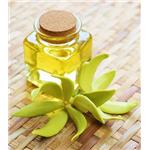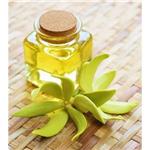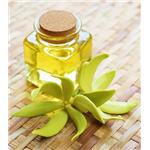- Ylang Ylang Oil
-

- $6.00 / 1KG
-
2025-03-10
- CAS:8006-81-3
- Min. Order: 1KG
- Purity: More than 99%
- Supply Ability: 2000KG/MONTH
- Ylang Ylang Oil
-

- $6.00 / 1kg
-
2025-03-10
- CAS:8006-81-3
- Min. Order: 1kg
- Purity: 99%
- Supply Ability: 2000KG/Month
- Ylang Ylang Oil
-

- $6.00 / 1KG
-
2025-02-28
- CAS:8006-81-3
- Min. Order: 1KG
- Purity: 99%
- Supply Ability: 20TONS
|
| | Ylang Ylang Oil Basic information |
| | Ylang Ylang Oil Chemical Properties |
| Safety Statements | 23-24/25 | | WGK Germany | 2 | | RTECS | EX2750000 | | Toxicity | LD50 oral in rat: > 5gm/kg |
| | Ylang Ylang Oil Usage And Synthesis |
| Chemical Properties | The flowers are steam-distilled a few hours after an early morning harvesting. Distillation may last up to 24 hours,
yielding approximately 1% essential oil. The various fractions withdrawn have different commercial values and characteristics.
Ylang-ylang is generally offered in what is known as fractions: Extra, first, second and third. Yet another oil offered is known as
a complete. Ylang-ylang essential oil extract consists of the volatile oil steam-distilled in the first few hours (Extra). The oil represents
approximately 35 to 40% of the total distilled yield and is considered the most valuable product. Specifications for this oil are
given below. This oil has a suave, floral odor. If exposed to light the oil loses its originally delicate and strong odor. Other grades of
oil—first-, second- and third-quality—are produced by continuing the steam distillation and withdrawing the various fractions by
specific gravity. The oils have a floral odor. In addition to these oils a complete ylang-ylang is also produced, which consists of the
total volatile fractions obtained by steam distillation of the flowers. All these oils vary in their physical–chemical characteristics. For
details of other quality oils, refer to Burdock (1997). | | Chemical Properties | For a long time, cananga and ylang-ylang trees were considered identical species. A more accurate study classified the
true cananga plant as the tree of Canangium odoratum Baill. f. macrophylla, whereas ylang-ylang was classified as Canangium odoratum
Baill. f. genuine. Cananga, a native of the Moluccas, grows wild or cultivated throughout tropical Asia and the islands of the
Indian Ocean. The tree may reach up to 30 m in height. Although it flowers year-round, the production peak occurs between October
and December. Cananga has a slightly woody, floral odor reminiscent of ylang-ylang and a burning taste. | | Chemical Properties | Ylang-ylang oils are obtained by steam distillation of freshly picked blossoms
of Cananga odorata (DC.) Hook. f. et Thomson ssp. genuina (Annonaceae).
These cananga trees normally grow to a height of 20m but are pruned
to a height of 1.60–1.80m and flower throughout the year. The oil is
produced in Madagascar and the Comoro Islands where quantities of 10 t
and 40 t, respectively, are obtained annually. Four fractions are collected at
progressively longer distillation times and are known as “Extra,” “I,” “II,” and
“III.” Occasionally, a first fraction called Extra superior is collected. They
are all pale to dark yellow liquids with a characteristic floral, spicy, balsamic
odor. The first fractions are the most valuable; they have a higher density
and a higher saponification number.
The compositions of the various oil fractions depend on the duration
of distillation. The first fraction, ylang-ylang oil Extra, has the highest
content of strongly odoriferous constituents such as p-cresyl methyl ether
(5–16%), methyl benzoate (4–9%), (?)-linalool (7–24%), benzyl acetate
(5.5–17.5%), and geranyl acetate (2.5–14%). The other fractions contain
increasing amounts of sesquiterpene hydrocarbons such as caryophyllene,
germacrene-D, and (E,E)-α-farnesene (in total >70% in ylang-ylang III).
Components such as p-cresol, eugenol, and isoeugenol are important for
the odor, although they are present only in low concentration.
Ylang-ylang Extra and I are used mostly in fine fragrances; ylang-ylang II
and III are employed in soap perfumes. | | Physical properties | The color of the oils ranges from light amber to yellow-brown. The Extra exhibits the deepest
color, probably because of phenolic substances. It should be noted that as the distillation proceeds, the specific gravity and the ester
content of these fractions decrease, whereas the optical rotation and the refractive index increase. The Extra fraction exhibits the
highest specific gravity and ester number, and the lowest optical rotation and refractive index, whereas the third fraction has the lowest
specific gravity and ester number and the highest optical rotation and refractive index. Thus, the quality of the various fractions
can be simply determined from their physicochemical properties. The Extra and first fractions possess the strongest and finest odor
because they contain the highest percentage of esters, ethers and phenols. The last fractions consist chiefly of sesquiterpenes and,
therefore, have little odor value. | | Uses | Ylang-ylang oil is a fragrance for use in various perfumed products; useful in soap perfumes and general perfumery as a floral additive of extremely
versatile application; blends with almost any other floral natural or synthetic material and gives good effects in a concentration of 0.5%
up to about 5% of the perfume base; some perfumery uses (candy; modifier and fixer in floral; ylang; Hyacinth jacinthe; Muguet Lily Of
The Valley; lily; camation Dianthus oeillet; Narcissus narcisse). | | Definition | An essential, yellowish, volatile
oil distilled from the flowers of Cananga odorata.
Strongly levorotatory. | | Essential oil composition | All qualities of the ylang-ylang oil contain the following components in varying ratios: d-α-pinene,
l-linalool, geraniol, benzyl alcohol and esters, p-cresol, p-cresyl acetate, eugenol, methyl benzoate, methyl salicylate and several
acids (formic, valeric, acetic, benzoic, salicyclic). | | Essential oil composition | Leaf: terpenes (α-pinene 14%, β-pinene 4.5%, myrcene 0.6%, limonene 0.4%, δ-elemene 1.1%, α-ylangene
0.3%, α-copaene 2.9%, β-cubebene 0.7%, β-caryophyllene 26.3%, α-amorphene 0.4%, α-humulene 6.3%, germacrene D 11.7%,
α-muurolene 1.1%, bicyclogermacrene 0.6%, γ-cadinene 0.8%, δ-cadinene 3%); oxygenated terpenic compounds (linalool 1.9%,
α-terpineol 0.3%, caryophyllene epoxide 0.6%, T-cadinol 0.9%, α-cadinol 0.8%); aliphatic alcohols (n-hexanol 10.2%, (Z)-hex-3-enol
3.1%, (E)-hex-2-enol 0.2%); (E)-hex-2-enal 2.0% (CoE, 2000). |
| | Ylang Ylang Oil Preparation Products And Raw materials |
|